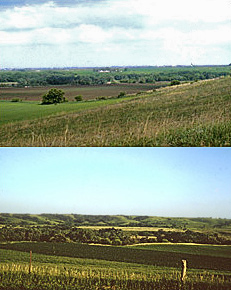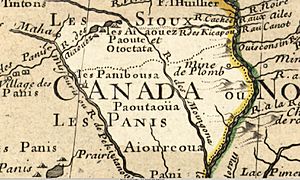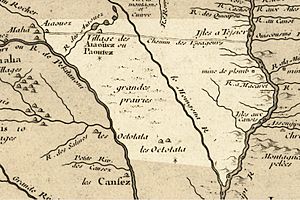Blood Run Site facts for kids
|
Blood Run Site
|
|
 |
|
| Nearest city | Sioux Falls, South Dakota, Granite, Iowa, and Canton, South Dakota |
|---|---|
| Built | 1300 (possibly built over three millennia) though the site was inhabited regularly for 8500 years in other than mound era dwelling. |
| Architect | Ho-Chunk, Ioway, Otoe, Missouri |
| Architectural style | Civic, Ceremonial, Effigy, and Burial Mounds. Including a 1.25 miles (2.01 km) long snake mound destroyed for railroad fill (1930s). |
| NRHP reference No. | 70000246 |
Quick facts for kids Significant dates |
|
| Added to NRHP | August 29, 1970 |
| Designated NHL | August 29, 1970 |
The Blood Run Site is an ancient place where people lived for thousands of years. It's right on the border of the US states of Iowa and South Dakota. This important archaeological site was home to many different Native American tribes.
People lived here for about 8,500 years! During this time, they built amazing earth structures called mounds. Tribes like the Ioway, Otoe, and Missouri lived here. Other tribes, including the Quapaw, Kansa, Osage, and Omaha, also shared this special place. The site got its name, "Blood Run," because the soil has a reddish color, like iron stains.
What is the Blood Run Site?
The Blood Run Site is a very old place where Native American people lived for a long, long time. It's known for its many earth mounds. These mounds were built for different reasons, like ceremonies, important community gatherings, or as burial sites.
Some of the mounds were even shaped like animals, called effigy mounds. One huge snake-shaped mound, possibly as long as 1.25 miles (2 kilometers), was once here. Sadly, parts of it were destroyed in the 1930s to build a railroad.
A Long History of Life

Many different Native American groups often visited and traded at Blood Run. Tribes like the Arikara, Dakota, and Cheyenne were regular traders. Sometimes, people from the Dakota and Arikara tribes even lived there. The site is located near Sioux Falls, South Dakota, between Granite, Iowa, and Harrisburg, South Dakota.
In the early 1700s, French traders called voyageurs mapped the Blood Run village. At that time, many Omaha people lived there. Records from that period suggest there were about 480 mounds and a population of around 10,000 Native people!
Protecting a Special Place
Blood Run is so important that it was named a National Historic Landmark in 1970. This means it's a place with special historical value that needs to be protected.
However, over the years, parts of the site have been damaged. Some areas were destroyed by early settlers and people looking for artifacts. Today, about 78 mounds are still visible, most of them burial mounds.
To help protect this amazing place, the State of Iowa bought a large part of the site in 1987 to make it a state park. Later, in 2003, the State of South Dakota also decided to buy land in the area to protect it. In 2011, South Dakota Governor Dennis Daugaard announced a plan to buy even more land to preserve the Blood Run Historical Landmark area. This shows how important it is to keep this ancient site safe for future generations.


